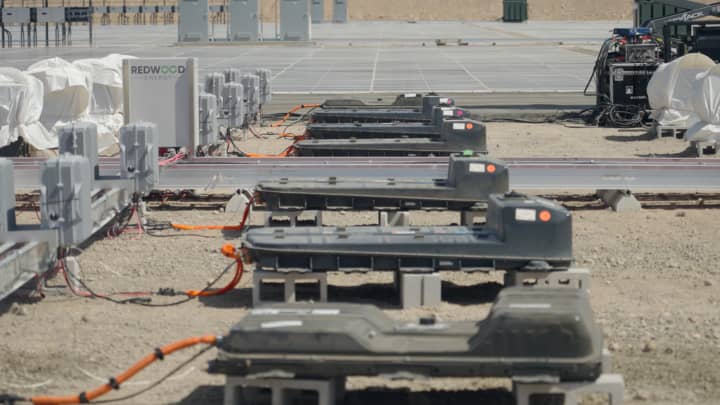In a world increasingly driven by artificial intelligence, energy demands are surging at unprecedented rates. Amidst this revolution, JB Straubel a key figure behind Tesla’s electric vehicle success has introduced a game changing idea, using old EV batteries to sustainably power AI data centers. Straubel, Tesla’s former Chief Technology Officer, launched Redwood Materials in 2017 to create a closed loop battery supply chain.
Initially focused on recycling, Redwood has now pivoted toward a powerful new use case: repurposing batteries that still retain usable energy. Instead of simply breaking them down, these batteries are being reengineered to serve as microgrid energy storage for data centers a move that could redefine how the AI industry accesses power.
The Problem Soaring Energy Demands of AI
AI data centers, particularly those running large language models and generative tools, require massive amounts of electricity. According to the International Energy Agency (IEA), the AI sector is expected to consume at least 10 times more energy by 2030 than it does today. This energy burden, combined with rising concerns over sustainability, has triggered a global search for alternative solutions.
Traditional data centers often rely on fossil fuel based power grids or carbon intensive backups like diesel generators. Straubel’s approach presents an eco friendly alternative, offering AI infrastructure a second chance through old EV batteries that are no longer viable for electric vehicles but still retain up to 70% of their original capacity.
How Redwood Materials’ Vision is Taking Shape
Redwood’s first major microgrid pilot is already in motion in Nevada. Collaborating with a small AI computing firm, Redwood deployed repurposed EV battery packs to power edge AI data centers focused on medical research. The site showed a 28% reduction in operational costs and drastically lowered carbon emissions compared to traditional grid powered setups.
Straubel describes the initiative as the perfect intersection of sustainable energy and next-gen computing. He adds that what’s being discarded as ‘used’ in the auto world can become a vital resource in another it’s about seeing value where others see waste.
Expert Opinions on Battery Repurposing for AI
Dr. Lisa Werner, a leading energy storage researcher at Stanford University, praises the initiative. Using old EV batteries for stationary storage is an underutilized solution. These batteries might not be fit for long distance driving anymore, but they are incredibly capable when it comes to consistent, localized energy support for data centers.
Tom Randle, an AI systems architect and green energy consultant, notes. The synchronization of EV battery reuse with the AI boom is not coincidental. Straubel’s insight into both electric vehicles and tech infrastructure allows him to see a synergy most in the industry miss.
By marrying clean energy storage with AI infrastructure, Redwood’s model might address two pressing challenges at once, the growing battery waste problem and the AI industry’s energy hunger.
The Technical Side How It Works
When EV batteries reach the end of their automotive life, they typically still retain 60 to 80% of their charging capacity. Redwood takes these batteries and reconfigures them into modular units. These units are then installed into microgrids that serve as backup or primary power sources for AI servers.
These microgrids include smart energy management software to optimize battery discharge, ensuring that AI data centers get reliable, consistent, and cost effective power even during peak hours or outages. This setup also integrates seamlessly with renewable energy sources like solar or wind, making it ideal for green data centers.
Jake Monroe, a former Tesla battery engineer who now works at Redwood, shared his experience. When I left Tesla, I thought I was done with EV batteries. But at Redwood, I realized their second life could be even more impactful. Watching an AI lab run entirely on repurposed energy it’s beyond satisfying.
Elena Garcia, a sustainability officer at a tech startup using Redwood’s storage solutions, added. It was important for us not just to use clean energy but also to support circular economy practices. Knowing our AI computations are powered by old EV batteries makes our mission feel more complete.
The Economics and Future Impact
Repurposing batteries isn’t just good for the planet it’s also economically sound. Producing new lithium ion batteries is expensive and resource intensive. By reusing existing cells, Redwood reduces costs by up to 40%, a savings that’s being passed on to companies investing in AI infrastructure.
Moreover, this model could significantly delay the need for large scale battery recycling, giving industries more time to develop efficient end of life strategies. Analysts believe that by 2030, second life battery applications could account for 10 to 15% of global energy storage solutions.
Of course, challenges remain. Not all old batteries are in good enough condition to be repurposed. Standardization and safety protocols also need to be updated to support widespread adoption.
However, with strong leadership, regulatory support, and growing demand, experts believe these issues are surmountable. JB Straubel remains optimistic. In a recent interview, he said, We’re at the beginning of a revolution in how we view energy assets. Old doesn’t mean obsolete it can mean opportunity.
A Circular Future for AI and Energy
Straubel’s work with Redwood Redwood offers a visionary roadmap for the future: one where old EV batteries become cornerstones of green AI innovation. In a world where both sustainability and technological growth are paramount, this approach delivers on both fronts.
As AI continues to evolve, the infrastructure powering it must evolve too and thanks to visionaries like JB Straubel, that future looks a lot cleaner, smarter, and more circular.

